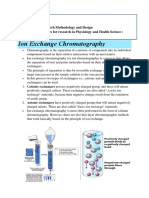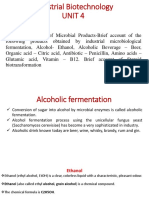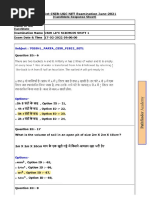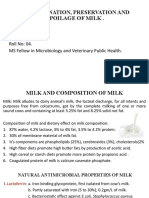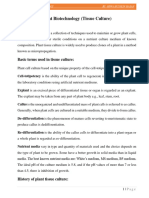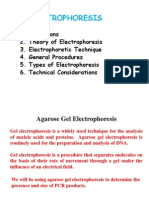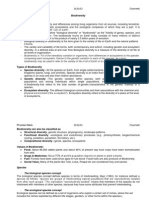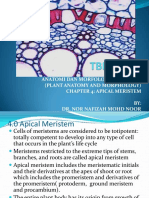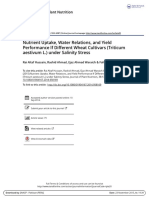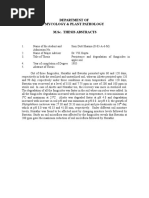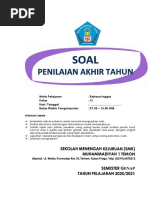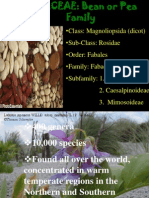Practical Exercise No. Notes. V.P.S. Shekhawat Cell Inclusions: Starch Grains (Potato and Rice) Aleurone Layer (Maize)
Practical Exercise No. Notes. V.P.S. Shekhawat Cell Inclusions: Starch Grains (Potato and Rice) Aleurone Layer (Maize)
Uploaded by
vijendCopyright:
Available Formats
Practical Exercise No. Notes. V.P.S. Shekhawat Cell Inclusions: Starch Grains (Potato and Rice) Aleurone Layer (Maize)
Practical Exercise No. Notes. V.P.S. Shekhawat Cell Inclusions: Starch Grains (Potato and Rice) Aleurone Layer (Maize)
Uploaded by
vijendOriginal Description:
Original Title
Copyright
Available Formats
Share this document
Did you find this document useful?
Is this content inappropriate?
Copyright:
Available Formats
Practical Exercise No. Notes. V.P.S. Shekhawat Cell Inclusions: Starch Grains (Potato and Rice) Aleurone Layer (Maize)
Practical Exercise No. Notes. V.P.S. Shekhawat Cell Inclusions: Starch Grains (Potato and Rice) Aleurone Layer (Maize)
Uploaded by
vijendCopyright:
Available Formats
Practical Exercise No. Notes. V.P.S.
Shekhawat
Cell inclusions: Starch grains (Potato and Rice); Aleurone Layer (Maize)
Aim:
Study of various cell inclusions
Theory:
The stored energy in plant tissues is preserved in the form of form of carbohydrates, lipids and
proteins. Plant cells deposit storage resources of carbohydrates, proteins, and neutral lipids in
subcellular particles termed starch granules, protein bodies, and oil bodies, respectively.
Starch is abundant in all major agricultural crops. Although it is the major energy reserve for a
large variety of higher plants such as cereals, legumes and roots and tubers, over 90% of world
starch production comes from cereals. Maize is by far the most important source of starch in the
world contributing to over 80% of world starch production, while wheat (>8%), potato (>5%),
and cassava (>5%) mainly share the rest of the production. Starches such as rice, barley, oats,
sweet potato, sago, etc., also contribute to the world starch production in small quantities.
Native starches have diverse properties and have been utilized for various food (54%) and
nonfood (46%) applications. Physical and chemical modifications have been employed to
improve the properties of native starches and make starch derivatives, and therefore widen the
scope of their applications.
Starch and starch derivatives have a growing demand in the industry because it is a renewable
and biodegradable resource, abundant, environmentally friendly, cost competitive, and versatile.
Storage starch is deposited in the endosperm (in amyloplasts) of the seed, while transient starch
is deposited in leaves (in chloroplasts). Starch is deposited as semicrystalline granules and
consists of two main glucan polymers named amylose and amylopectin. Amylose is
essentially a linear polymer with - (1,4) linkages between glucose units, amylopectin is highly
branched polyglucan. In amylopectin molecules, linear chains connecting glucose monomers via
-(1,4)-linkages, are interconnected via -(1,6) linkages. The starch granule is mainly (98- 99%)
composed of amylose and amylopectin, as discussed above. Although, the ratio of amylose to
amylopectin in a normal starch is about 1:3, the exact value depends on the botanical origin.
Starch grains consists of hilum around which dense and watery starch layers are arranged. The
position of the hilum may be concentric or eccentric. The shape of the hilum may be pointed or
fissured. The aggregation of the Starch grains may be; simple, compound or semicompound.
Depending on the biological origin, starch granules demonstrate different shapes, sizes, and
morphology increasing its specificity in food applications. Variously shaped granules such as
lenticular/oval, round/spherical, polygonal, disk, truncated ellipsoid, and irregular are found in
nature with size ranging from 1 to 100 m in diameter. Granules from roots and tuber starches
are relatively larger in size (2-100 m) and have oval shape although some varieties with round,
polygonal, and irregularly shape granules are found.
(A) Potato Starch
Obtained from the tubers of Solanum tuberosum, family Solanaceae. The granules are flatten
ovoid or sub spherical up to 100m. Few granules are compound, with 2 or 3 components. The
hilum is a point at the narrow end of the granules and concentric striations are well marked. It is
used as a disintegrant in making tablets.
Requirement:
1. Potato tubes
2. Slides
3. Cover Slips
4. Beakers
5. Muslin Cloth
6. Iodine Solution
7. Glycerine
Procedure:
1. Peal a raw potato and cut into small pieces
2. Grind them in a motor and pestle with sufficient water.
3. Collect the potato homogenate into a beaker and add enough water.
4. Then filter the homogenate through a muslin cloth to remove the particles.
5. Allow the filtrate to settle. Starch rapidly settles at the bottom. Decant the starch free
supernatant carefully.
6. Wash 3-4 times and decant the supernatant. Collect the compact mass of starch and allow
it to dry.
7. Observe the isolated starch
(B) Rice Starch
It is isolated from rice grains (From the fruits of Oryza sativa family-Poaceae). Individual
granules of rice starch measure from 3-5 to86 m in diameter. They are polyhedral with sharp
angles without concentric striations; a hilum is visible in the larger granules. Compound
granules are present and consist of from 2-150 components.
Requirements:
1. Rice Grains
2. Slides
3. Cover Slips
4. Beakers
5. Muslin Cloth
6. Iodine Solution
7. Glycerine
Isolation Procedure
1. Take 100g of broken pieces rice and wash them to remove the impurities.
2. Now crush them in powder form and soak them in sufficient amount of 0.4% NaOH
solution for 20 minutes to soften them.
3. This ground mixture is mixed with water for 20 minutes.
4. The mixture is then stirred on a magnetic stirrer for 5 mins
5. Filter it using a muslin cloth
6. The remaining filtrate is allowed to stand in a beaker for some time.
7. The starch will settle down and will be separated and dried and identification tests can be
now performed on this starch.
(C). Maize Starch
It is prepared from grains of fruit of Zea mays family Poaceae. Maize Starch consists of grains
that are nearly uniform in size Consists of granule that are fairly uniform in size measuring 5-25
m, they are polyhedral with blunt angles or more or less rounded. In the center there is often a
small cleft, or two or three radiatingfrom the center, the position of the hilum. The granules are
mostly simple.
Isolation Procedure
1. Maize grains are first washed with running water to get rid of dust particles and adhered
organic matters.
2. They are now softened by soaking in water for 12 to 24 hrs
3. Crush them to separate the embryo and the epicarp.
4. Add distilled water and filter it using a muslin cloth
5. The milky slurry thus obtained is a mixture of starch and gluten particles which is then
subjected to centrifugation
6. Thus, the starch which being relatively heavier settles at the bottom and the gluten being
lighter floats on the surface and removed quickly by a jet of water.
Observations:
Macroscopic Characteristics:
S.No. Characters Description
Potato Rice Maize
1. Form Fine Powder In masses Fine Powder
2. Color Slightly Yellowish White White
3. Odour None None None
4. Taste Mucilaginous Mucilaginous Mucilaginous
5. Solubility Gives colloidal
solution when boiled
with water
Gives colloidal
solution when boiled
with water
Gives colloidal
solution when
boiled with
water
6. pH Neutral/Faint Acidic Alkaline Neutral
Microscopic Characteristics:
S.No
.
Characters Description
Potato Rice Maize
1. Nature Mostly Simple, but
occasionally compound
Simple and
Compound
Simple
2. Shape Subspherical or ovoid
and often slightly
flattened
Polyhedral with
sharp angles
Polyhedral or
rounded
3. Size Subspherical grains are
upto 35 micrometer in
length and ovoid grain
vary from 30 to 100
micrometer
4-10 micro meter but
average grains are
about 6 micro meter
compound grains
may contain upto 150
components and may
measure upto 30
micrometer in width
and 20 micrometer in
length
5-30 micro meter
Majority with 12-18
micro meter
4. Hilum and
Striations
The hilum occurs as a
small point towards the
narrower end of the
grain and is surrounded
by well marked
concentric striations
No striations are
visible and only very
occasionally a hilum
can be distinguished
as a small central
dot.
The grain exhibit no
concentric striations,
but a hilum can
usually be seen either
as a central point or
as a 2-5 rayed
fissure.
Observation and result:
Aleurone Layer (Maize)
The mature corn kernel is composed of four principle parts: tip cap, 0.8%; pericarp, 5.3%; germ,
11.9%; and endosperm, 82% . Immediately beneath the testa is the first layer of the endosperm,
the aleurone, a single layer of highly proteinaceous cells having thick, tough cell walls. Aleurone
comprises about 3% of the weight of the kernel. Although structurally part of the endosperm, the
aleurone, along with the pericarp and tip cap, is included in the fiber fraction.
(1) Cut thin sections transverse and longitudinal sections of the grain
(2) Place a section in a little Millon's reagent ; if the protein contents do not turn red quickly,
warm the slide.
(3) Note that the greater portion of the endosperm consists of cells packed with starch-grains, but
the outer- most layer (" aleurone " layer) consists of cubical cells containing protein grains.
Protein Grains ("Aleurone" Grains) are found in various parts where food is stored, but are
especially abundant and large in seeds.
You might also like
- Unit 2 - Molds MorphologyDocument11 pagesUnit 2 - Molds MorphologyMinh DuyNo ratings yet
- Watermelon FertigationDocument2 pagesWatermelon FertigationJose Ramon Ruiz Ledezma100% (3)
- 7days Internship Report-20102068,72,75,115Document11 pages7days Internship Report-20102068,72,75,115ParthasarathiNo ratings yet
- Dark Field MicrosDocument1 pageDark Field MicrosPatrick ManriqueNo ratings yet
- Chapter 4 - Explant Preparation - 2013 - Plant Tissue Culture PDFDocument7 pagesChapter 4 - Explant Preparation - 2013 - Plant Tissue Culture PDFLuis BermudezNo ratings yet
- KT106 GeNei™ Immunoglobulin G Isolation Teaching KitDocument9 pagesKT106 GeNei™ Immunoglobulin G Isolation Teaching KitHemant KawalkarNo ratings yet
- Ion Exchange, Molecular Sieve, AffinityDocument11 pagesIon Exchange, Molecular Sieve, AffinityNofrizalNo ratings yet
- Neurospora - WikipediaDocument3 pagesNeurospora - WikipediakoiNo ratings yet
- Practical - Turbidimetric MethodsDocument9 pagesPractical - Turbidimetric MethodsProbioticsAnywhere100% (1)
- Unit 7 Operon ConceptDocument18 pagesUnit 7 Operon ConceptSarah PavuNo ratings yet
- 2.microscopy Principles and TypesDocument15 pages2.microscopy Principles and TypesPravin sawantNo ratings yet
- PSSMDocument17 pagesPSSMrayx_1No ratings yet
- Food and Industrial Microbiology: Practical ManualDocument108 pagesFood and Industrial Microbiology: Practical Manualgmanju207No ratings yet
- THEORIES OF SHOOT APICAL MERISTEM NotesDocument11 pagesTHEORIES OF SHOOT APICAL MERISTEM NotesAbhimanyu Pandey100% (2)
- Antibodies Structure and FunctionDocument16 pagesAntibodies Structure and Functionياسين احمد علي الشيخNo ratings yet
- Somatic Embryogenesis: Meaning, History, Principles, Protocols and ImportanceDocument11 pagesSomatic Embryogenesis: Meaning, History, Principles, Protocols and ImportanceAlka PriyadarshiniNo ratings yet
- Enzyme Immobilization Techniques Lecture Notes PDFDocument13 pagesEnzyme Immobilization Techniques Lecture Notes PDFPriyanka KasturiaNo ratings yet
- IsotypeDocument17 pagesIsotypeReshmiAkhilNo ratings yet
- Industrial BiotechnologyDocument57 pagesIndustrial BiotechnologyKavyaNo ratings yet
- Lecture Notes (Theory and Practice of Sterilization)Document5 pagesLecture Notes (Theory and Practice of Sterilization)Zearo GamingNo ratings yet
- Auto RadiographyDocument15 pagesAuto RadiographyShelvy SNo ratings yet
- Embryology Lecture Notes - 2 Cleavage and TypesDocument6 pagesEmbryology Lecture Notes - 2 Cleavage and TypestrivikramraoNo ratings yet
- Overlapping GenesDocument10 pagesOverlapping GenesAparna AbiNo ratings yet
- Problems Encountered by Researchers in IndiaDocument2 pagesProblems Encountered by Researchers in IndiaBarun Bhardwaj50% (2)
- Quorum SensingDocument20 pagesQuorum SensingTrupti JobNo ratings yet
- Protein Assay by Bradford MethodDocument4 pagesProtein Assay by Bradford MethodChadby GraNaNoNo ratings yet
- Suppressor MutationsDocument46 pagesSuppressor MutationsBobbyWhiteNo ratings yet
- Life Sciences Question Papers 2021 Shift 1Document90 pagesLife Sciences Question Papers 2021 Shift 1tauhidj100% (1)
- Biological Search EnginesDocument3 pagesBiological Search EnginesShubham PawadeNo ratings yet
- Contamination, Preservation and Spoilage of Milk andDocument16 pagesContamination, Preservation and Spoilage of Milk andAbu Al FarabiNo ratings yet
- Classification of Medically Important BacteriaDocument2 pagesClassification of Medically Important BacteriaAUNG KHANT ZAWNo ratings yet
- Lesson-12 Metachromatic Staining PDFDocument5 pagesLesson-12 Metachromatic Staining PDFSasa AbassNo ratings yet
- Cell Cycle & Its RegulationDocument16 pagesCell Cycle & Its RegulationElina GNo ratings yet
- Little Leaf of BrinjalDocument64 pagesLittle Leaf of BrinjalPARITOSH SHARMANo ratings yet
- SRIDDocument4 pagesSRIDd_caasiNo ratings yet
- Microbial NutritionDocument8 pagesMicrobial NutritionManohar PattarNo ratings yet
- XI-Biology Ch-3 Plant Kingdom PPT-2Document14 pagesXI-Biology Ch-3 Plant Kingdom PPT-210080No ratings yet
- An Introduction To Cloning and Recombinant DNADocument29 pagesAn Introduction To Cloning and Recombinant DNAJon FaizalNo ratings yet
- Genei: Gel Filtration Chromatography Teaching Kit ManualDocument7 pagesGenei: Gel Filtration Chromatography Teaching Kit ManualHemant KawalkarNo ratings yet
- Cmb-Ppt-5-Endoplasmic Reticulum-Borja, Jayven CDocument11 pagesCmb-Ppt-5-Endoplasmic Reticulum-Borja, Jayven CJboar TbenecdiNo ratings yet
- Inheritance Biology EDUNCLEDocument54 pagesInheritance Biology EDUNCLEEvita Almeida100% (1)
- Plant Biotechnology (Tissue Culture)Document11 pagesPlant Biotechnology (Tissue Culture)Hewa HusenNo ratings yet
- MY 1st Sem. Presttn DNA Damage & Repair PPT MW 2003Document26 pagesMY 1st Sem. Presttn DNA Damage & Repair PPT MW 2003Samhita Kalita100% (1)
- ElectrophoresisDocument45 pagesElectrophoresisPagla HowaNo ratings yet
- CryopreservationDocument18 pagesCryopreservationgaurav saxenaNo ratings yet
- The Concept of TotipotencyDocument15 pagesThe Concept of Totipotencynmaars0% (1)
- Introduction To Bergey's ManualDocument16 pagesIntroduction To Bergey's ManualJohn Diestro100% (1)
- Kinetic Model of Growth and Product FormationDocument7 pagesKinetic Model of Growth and Product FormationfayeNo ratings yet
- Phyllotaxy of LeafDocument3 pagesPhyllotaxy of LeafJanine TugononNo ratings yet
- Wood AnatomyDocument15 pagesWood Anatomymanojtbgri5793No ratings yet
- Cointegrated VectorsDocument2 pagesCointegrated Vectorsdevikamurugan124206No ratings yet
- Practical - Immobilization of EnzymesDocument4 pagesPractical - Immobilization of EnzymesAditi Patil100% (2)
- Stem Cells - Sources, Characteristics, Types, Uses - Developmental Biology - Microbe NotesDocument5 pagesStem Cells - Sources, Characteristics, Types, Uses - Developmental Biology - Microbe NotesAmar Kant JhaNo ratings yet
- Spoilage of Protein & CarbsDocument43 pagesSpoilage of Protein & CarbsA RahmanNo ratings yet
- Microsporogenesis Callose Deposition and Its SignificanceDocument10 pagesMicrosporogenesis Callose Deposition and Its SignificanceGYANRANJAN MAHALIKNo ratings yet
- Kinetics of Immobilized EnzymeDocument10 pagesKinetics of Immobilized EnzymeHari KumarNo ratings yet
- Mixed Lymphocyte Culture / Reaction (MLC / MLR)Document2 pagesMixed Lymphocyte Culture / Reaction (MLC / MLR)Muthi KhairunnisaNo ratings yet
- 385163146classificationof Algae by FritschDocument16 pages385163146classificationof Algae by FritschAnshita RajputNo ratings yet
- Intellectual Property Rights in Pharmaceutical Industry: Theory and PracticeFrom EverandIntellectual Property Rights in Pharmaceutical Industry: Theory and PracticeNo ratings yet
- FY Transport of WaterDocument4 pagesFY Transport of WatervijendNo ratings yet
- TerrariumDocument3 pagesTerrariumvijendNo ratings yet
- Alerone LayerDocument11 pagesAlerone LayervijendNo ratings yet
- What Is Somatic Embryogenesis? Discuss Important Phases, Factors Affecting and Various Applications of Somatic EmbryogenesisDocument1 pageWhat Is Somatic Embryogenesis? Discuss Important Phases, Factors Affecting and Various Applications of Somatic EmbryogenesisvijendNo ratings yet
- M.Sc.I CAMDocument22 pagesM.Sc.I CAMvijendNo ratings yet
- Plant Tissue Culture MediaDocument34 pagesPlant Tissue Culture MediavijendNo ratings yet
- FY PhytoremediationDocument11 pagesFY PhytoremediationvijendNo ratings yet
- SY Culture MediaDocument2 pagesSY Culture MediavijendNo ratings yet
- Promoters Used in Vector Construction For Genetic Engineering in Plants S.Y. Botany - IIIDocument2 pagesPromoters Used in Vector Construction For Genetic Engineering in Plants S.Y. Botany - IIIvijendNo ratings yet
- FY Lecture Notes BiodiversityDocument2 pagesFY Lecture Notes Biodiversityvijend100% (2)
- Bioremediation Strategies LecturesDocument1 pageBioremediation Strategies LecturesvijendNo ratings yet
- T.Y. B.Sc. LiposomesDocument3 pagesT.Y. B.Sc. LiposomesvijendNo ratings yet
- Ecosystem ProductivityDocument2 pagesEcosystem ProductivityvijendNo ratings yet
- Plant Nutrition NotesDocument4 pagesPlant Nutrition Notesvijend100% (1)
- Hatch and Slack PathwayDocument8 pagesHatch and Slack Pathwayvijend0% (1)
- Human KaryotypeDocument1 pageHuman KaryotypevijendNo ratings yet
- Production of Alcohol Lecture NotesDocument3 pagesProduction of Alcohol Lecture Notesvijend100% (4)
- Flow Cytometr1Document3 pagesFlow Cytometr1vijendNo ratings yet
- Stem Cell LabDocument3 pagesStem Cell LabVikash kumarNo ratings yet
- 20170918140947SBC 3023 - TBB 2033beditednew4Document36 pages20170918140947SBC 3023 - TBB 2033beditednew4Leena MuniandyNo ratings yet
- Module - 2 - Biological ClassificationDocument10 pagesModule - 2 - Biological ClassificationShuvadipta DasNo ratings yet
- Abiotic and Biotic FactorsDocument3 pagesAbiotic and Biotic FactorsEmily Torrace Dunbar100% (1)
- Full Download How Would Buddha Think 1 501 Right Intention Teachings for Cultivating a Peaceful Mind 1st Edition Barbara Ann Kipfer PDF DOCXDocument82 pagesFull Download How Would Buddha Think 1 501 Right Intention Teachings for Cultivating a Peaceful Mind 1st Edition Barbara Ann Kipfer PDF DOCXbirtaternan100% (7)
- The Last Tree Story HandoutsDocument1 pageThe Last Tree Story HandoutsOrtaleza Dumaguing Judy AnnNo ratings yet
- Glathadevi, 24Document1 pageGlathadevi, 24Kurumbapatty Zoolagical ParkNo ratings yet
- tmp46D7 TMPDocument12 pagestmp46D7 TMPFrontiersNo ratings yet
- Worlds Together Worlds Apart Fourth Edition Volume One all chapter instant downloadDocument24 pagesWorlds Together Worlds Apart Fourth Edition Volume One all chapter instant downloadferatpepshi100% (3)
- Transport in PlantsDocument26 pagesTransport in Plantsliban100% (2)
- Seeds and Seed GerminationDocument57 pagesSeeds and Seed GerminationAnonymous 77mrXm5No ratings yet
- Topic 4 BiodiversityDocument20 pagesTopic 4 BiodiversityNoorizan Mohd EsaNo ratings yet
- Sistematika Hewan: PendahuluanDocument31 pagesSistematika Hewan: PendahuluanElpe BibasNo ratings yet
- Citrus ScabDocument1 pageCitrus ScabUyu SalNo ratings yet
- MPP MSC AbstractsDocument100 pagesMPP MSC AbstractsrohitNo ratings yet
- FMB1997012002010Document9 pagesFMB1997012002010kalenjiindonesiaNo ratings yet
- Soal Pat B.Inggris XI 2020Document13 pagesSoal Pat B.Inggris XI 2020Agustin Dewi PramitasariNo ratings yet
- Prima Nuvela-Anita Desai-Games at TwilightDocument38 pagesPrima Nuvela-Anita Desai-Games at TwilightRuxandra Dragomir0% (1)
- Cresterea Tomatelor in SeraDocument10 pagesCresterea Tomatelor in SeraAdy PierreNo ratings yet
- Here Are The Ages, in Years, of 15 StudentsDocument7 pagesHere Are The Ages, in Years, of 15 StudentsSamyukta NairNo ratings yet
- AS Biology Unit 2 Topic 4 Notes Study Revision Guide Summary Edexcel Practice Biodiversity Plant Cell OrganellesDocument50 pagesAS Biology Unit 2 Topic 4 Notes Study Revision Guide Summary Edexcel Practice Biodiversity Plant Cell Organellesshamxrock90% (59)
- FabaceaeDocument42 pagesFabaceaeRaul RujoiNo ratings yet
- Amylase LabDocument2 pagesAmylase LabadfadfwoiejcNo ratings yet
- Hello-WPS OfficeDocument10 pagesHello-WPS OfficekunyaynatheeNo ratings yet
- 01+Tree+of+life+IDocument50 pages01+Tree+of+life+IThanusi LogathasNo ratings yet
- Let's Learn!: ©tara West Little Minds at Work Blog Whimsy ClipsDocument1 pageLet's Learn!: ©tara West Little Minds at Work Blog Whimsy Clipsapi-505681779No ratings yet
- Partial List Heirloom Tomato Refs Seed Source 08Document2 pagesPartial List Heirloom Tomato Refs Seed Source 08pierrecmoeller1159No ratings yet
- Biology: Single Correct Questions +1 - 0Document18 pagesBiology: Single Correct Questions +1 - 0Abhishek PatilNo ratings yet
- Allomorphic Study of Zinnia Elegans Species Collected From Gilgit, PakistanDocument8 pagesAllomorphic Study of Zinnia Elegans Species Collected From Gilgit, PakistankiubioassignmentsNo ratings yet







